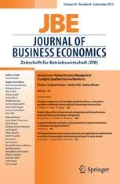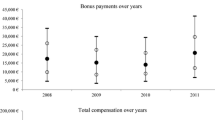Abstract
We explore the dispersion of bonus payments of managers within and between five large firms from the German chemical sector and disentangle the dispersion within and between levels of the hierarchy. We use data from a yearly salary survey in these firms during the observation period 2008 to 2013. Bonus payments account for one quarter of yearly base salaries on average. Both the amount and the dispersion of bonus-to-base ratios differ across firms. We disentangle the dispersion between and within the levels of firms’ hierarchies. Revealed differences, which are consistent with differences in firms’ value statements, suggest that there is no one best incentive system of a firm.



Similar content being viewed by others
Notes
The data have been used for other research questions before. Grund and Walter (2015) explore the role of the financial crises for (changes in) compensation of middle managers. Besides Grund (2015) focuses on component specific gender pay gaps for a homogeneous subsample (employees holding a doctorate degree in a STEM field). Grund and Kräkel (2012) have provided first cross-sectional evidence on determinants of bonus relevance in the sector. We refer to the latter paper below.
In their longitudinal study, Grund and Walter (2015) explore the impact of the economic crises on managers’ compensation more in detail. They find that fixed salaries are hardly affected, whereas bonus payments considerably decreased from 2008 to 2010. Total compensation recovered quite fast, though. Managers report real increases in remuneration in 2011 compared to the pre-crises year 2008 on average.
Additionally, previous empirical studies demonstrate that firm strategy is a significant predictor of middle managers’ pay systems (Guth and MacMillan 1986; Napier and Smith 1987; Balkin and Gomez-Mejia 1990; Boyd and Salamin 2001; Yanadori 2011). R&D intensity (calculated as the ratio of annual R&D expense to annual sales) is widely used in the literature to measure the strategic orientation of a firm (Griliches 1986; Balkin and Gomez-Mejia 1987; Gerhart and Milkovich 1990). R&D intensity generally reflects a firm innovation strategy that captures both long-term orientation and the willingness to bear risk (Yoshikawa et al. 2010). Consequently, the differences in a firm’s alignment to R&D might lead to differences in the use of bonus payments (Yanadori and Marler 2006). However, it should be noted that the main effects of seniority, functional area and hierarchy in the pooled OLS regression of Table 2 and firm-wise OLS regressions of Table 3 are robust to estimations with the control for R&D intensity instead of year dummies or EBIT performance.
Notably, there was an additional bonus payout in Firm D in 2013, based on the achievement of main targets in the 2012 fiscal year. Focusing on the 2008 to 2012 fiscal years only, Fig. 3 shows that bonus-to-base ratios vary considerably within Firm D year-on-year.
Notably, bonus payments of Firm C were partly brought forward from fiscal year 2011 (2012) to fiscal year 2010 (2011). There were some extra bonus payments for exceptional performance in 2011, too. Leaving aside these years of observation, a generally low spread of bonus relevance, as in Firm A and Firm E, can be observed, as shown in Fig. 3.
References
Autor DH, Katz LF, Kearney MS (2008) Trend in US wage inequality: revising the revisionists. Rev Econ Stat 90(2):300–323
Baker G, Gibss M, Holmström B (1994) The Wage policy of a firm. Q J Econ 109(4):921–955
Balkin DB, Gomez-Mejia LR (1987) Toward a contingency theory of compensation strategy. Strateg Manag J 8(2):169–182
Balkin DB, Gomez-Mejia LR (1990) Matching compensation and organizational strategies. Strateg Manag J 11(2):153–169
Baron JN, Pfeffer J (1994) The social psychology of organizations and inequality. Soc Psychol Q 57(3):190–209
Barth E, Bryson A, Davis JC, Freeman R (2016) It’s where you work: increases in earnings dispersion across establishments and individuals in the USA. J Labor Econ 34(2):s67–s97
Birkner, G. (2016). Teamgeist zahlt sich bei Bosch aus. In: Comp&Ben, col 3, pp 24–26. http://www.compbenmagazin.de/wp-content/uploads/sites/7/2016/07/8_Artikel_Teamgeist.pdf
Bloom M (1999) The performance effects of pay dispersion on individuals and organizations. Acad Manag J 42(1):25–40
Bloom M, Michel JG (2002) The relationship among organizational context, pay dis-persion, and among managerial turnover. Acad Manag J 45(1):33–42
Boyd BK, Salamin A (2001) Strategic reward systems: a contingency model of pay system design. Strateg Manag J 22(8):777–792
Card D, Heining J, Kline P (2013) Workplace heterogeneity and the rise of German Wage inequality. Q J Econ 128(3):967–1015
Danilov A, Harbring C, Irlenbusch B (2014) Helping in teams. IZA Discussion Paper, No. 8707
Dohmen TJ (2004) Performance, seniority, and Wages: formal salary systems and individual earnings profiles. Labour Econ 11(6):741–763
Dohmen TJ, Lehmann H, Schaffer ME (2014) Wage policies of a Russian firm and the financial crisis of 1998: evidence from personnel data, 1997 to 2002. Ind Labor Relat Rev 67(2):504–531
Eriksson T, Lausten M (2000) Managerial pay and firm performance—Danish evidence. Scand J Manag 16(3):269–286
Fama EF (1980) Agency problems and the theory of the firm. J Polit Econ 88:288–307
Frederiksen A, Lange F, Kriechel B (2017) Subjective performance evaluations and employees careers. J Econ Behav Organ 134:408–429
Gerhart B, Milkovich GT (1990) Organizational differences in managerial compensation and financial performance. Acad Manag J 33(4):663–691
Gibbons R, Murphy KJ (1992) Optimal incentive contracts in the presence of career concerns: theory and evidence. J Polit Econ 100:468–505
Gomez-Meija LR (1992) Structure and process of diversification, compensation strategy, and firm performance. Strategy Manag J 13(5):381–398
Griliches Z (1986) Productivity, R&D, and basic research at the firm level in the 1970s. Am Econ Rev 76(1):141–154
Grund C (2005) The Wage policy of firms: comparative evidence for the US and Germany from personnel data. Int J Human Resour Manag 16(1):104–119
Grund C (2015) Gender pay gaps among highly educated professionals: compensation components do matter. Labour Econ 34:118–126
Grund C, Kräkel M (2012) Bonus payments, hierachy levels, and tenure: theoretical considerations and empirical evidence. Schmalenbach Bus Rev 64(2):102–124
Grund C, Walter T (2015) Management compensation and the economic crisis—longitudinal evidence from the German chemical sector. RMS 9:751–777
Grund C, Westergaard-Nielsen N (2008) The dispersion of employees’ wage increases and firm performance. Ind Labor Relat Rev 61:485–501
Guth WD, MacMillan IC (1986) Strategy implementation versus middle management self-interest. Strategy Manag J 7(4):313–327
Hambrick DC, Siegel PA (1997) Pay dispersion within top management groups: harmful effects on performance of high-technology firms. In: Academy of management, pp 26–29
Heyman F (2005) Pay inequality and firm performance: evidence from matched employ-er-employee data. Appl Econ 37(11):1313–1327
Holmström Bengt (1982) Managerial incentive problems—a dynamic perspective. In: Walross B (ed) Essays in economics and management in honor of Lars Wahlbeck. Swedish School of Economics, Helsinki, pp 209–230
Juhn C, Murphy KM, Pierce B (1993) Wage inequality and the rise in return to skill. J Polit Econ 101(3):410–442
Kampkötter P (2015) Non-executive compensation in German and Swiss banks before and after the financial crisis. Eur J Financ 21(15):1297–1316
Kampkötter P, Sliwka D (2018) More dispersion, higher bonuses? The role of differentiation in subjective performance evaluations. J Labor Econ 36:511–549
Klemm M, Sanderson S, Luffman G (1991) Mission statements: selling corporate values to employees. Long Reange Plan 24(3):73–78
Kräkel M, Schöttner A (2012) Internal labor markets and worker rents. J Econ Behav Organ 84:491–509
Lallemand T, Plasman R, Rycx F (2004) Intra-firm wage dispersion and firm performance: evidence from linked employer–employee data. Kyklos 57(4):533–558
Lawler III E, Jenkins D (1992) Strategic reward systems. Center of Effective Organizations Publications G92-2(295)
Lazear EP (1979) Why is there mandatory retirement. J Polit Econ 87(6):1261–1284
Lazear EP (1999) Personnel economics: past lessons and future directions. J Labor Econ 17(2):199–236
Lazear EP, Rosen S (1981) Rank-order tournaments as optimum labor contracts. J Polit Econ 89(5):841–864
Levine DI (1991) Cohesiveness, productivity, and wage dispersion. J Econ Behav Organ 15(2):237–255
Meyer WU, Bachmann M, Biermann U, Hempelmann M, Ploger FO, Spiller H (1979) The Informational value of evaluative behavior: influences of praise and blame on perceptions of ability. J Educ Psychol 71(2):259–268
Milgrom P, Roberts J (1992) Economics, organization and management. Prentice Hall, Upper Saddle River
Milkovich GT, Newman JM (2002) Compensation. Irwin, Chicago
Mossholder KW, Richardson HA, Settoon RP (2011) Human resource systems and helping in organizations: a relational perspective. Acad Manag Rev 36:33–52
Mueller HM, Ouimet PP, Simintzi E (2017a) wage inequality and firm growth. Am Econ Rev Papers Proc 107:379–383
Mueller HM, Ouimet PP, Simintzi E (2017b) Within-firm pay inequality wage. Rev Financ Stud 30:3605–3634
Napier NK, Smith M (1987) Product diversification, performance criteria and compensation at the corporate manager level. Strategy Manag J 8(2):195–201
Nash D (2003) Determinants of the use of financial incentives in investment banking. ESCR Center of Business Research Working paper No. 256
Nyberg AJ, Maltarich MA, Abdulsalam D, Essman SE, Cragun O (2018) Collective pay for performance: a cross-disciplinary review and meta-analysis. J Manag 44(6):2433–2472
Ortín-Ángel P, Salas-Fumás V (1998) Agency-theory and internal-labor-market explanations of bonus payments: emperical evidence from spanish firms. J Econ Manag Strategy 7(4):573–613
Pearce JA, David F (1987) Corporate mission statements: the bottom line. Acad Manag Exec 1(2):109–116
Pfeffer J, Langton N (1993) The effect of wage dispersion on satisfaction, productivity and working collaboratively: evidence from college and university faculty. Adm Sci Q 38(3):382–407
Pfeifer C (2008) An empirical note on wages in an internal labour market. Econ Lett 99(3):570–573
Pitts RA (1980) Toward a contingency theory of multi-business organization design. Acad Manag J 5(2):203–210
Rajagopalan N (1997) Strategic Orientations, incentive plans adaptions, and firm performance: evidence from electric utility firms. Strateg Manag J 18(10):761–785
Salter MS (1973) Tailor incentive compensation to strategy. Harvard Bus Rev 51(2):94–102
Schein EH (2004) Organizational culture and leadership. Jossey-Bass, San Francisco
Schuler RS, Rogovsky N (1998) understanding compensation practice variation across firms: the impact of national culture. J Int Bus Stud 29(1):159–177
Shorrocks AF (1980) The class of additively decomposable inequality measures. Econometrica 48(3):613–625
Siegel PA, Hambrick DC (2005) Pay disparities within top management groups: evidence of harmful effects on performance of high-technology firms. Organ Sci 16(3):259–274
Stroh LK, Brett JM, Baumann JP, Reilly AH (1996) Agency theory and variable pay compensation strategies. Acad Manag 39(3):751–767
Taylor SE, Brown JD (1988) Illusion and well-being: a social psychological perspective on mental health. Psychol Bull 103(2):193–210
Theil H (1967) Economics and information theory. Amsterdam
Winter-Ebmer R, Zweimüller J (1999) Intra-firm wage dispersion and firm performance. Kyklos 52(4):555–572
Yanadori Y (2011) Paying both globally and locally: an examination of the compensation management of a US multinational finance firm in the Asia Pacific Region. Int J Human Resour Manag 22(18):3867–3887
Yanadori Y, Jaarsveld DD (2014) Relationships of informal high performance work practices to job satisfaction and workplace profitability. Ind Relat 53(3):501–534
Yanadori Y, Kang S (2011) Intra-firm differentiation of compensation systems: evidence from US high-technology firms. Human Resour Manag J 21(3):236–257
Yanadori Y, Marler JH (2006) Compensation strategy: does business strategy influence compensation in high-technology firms? Strateg Manag J 27(6):559–570
Yoshikawa T, Rasheed AA, Del Brio EB (2010) The Impact of firm strategy and foreign ownership on executives bonus compensation in Japanese firms. J Bus Res 63(11):1254–1260
Author information
Authors and Affiliations
Corresponding author
Appendix
Appendix
Rights and permissions
About this article
Cite this article
Grund, C., Hofmann, T. The dispersion of bonus payments within and between firms. J Bus Econ 89, 417–445 (2019). https://doi.org/10.1007/s11573-018-0920-x
Published:
Issue Date:
DOI: https://doi.org/10.1007/s11573-018-0920-x



